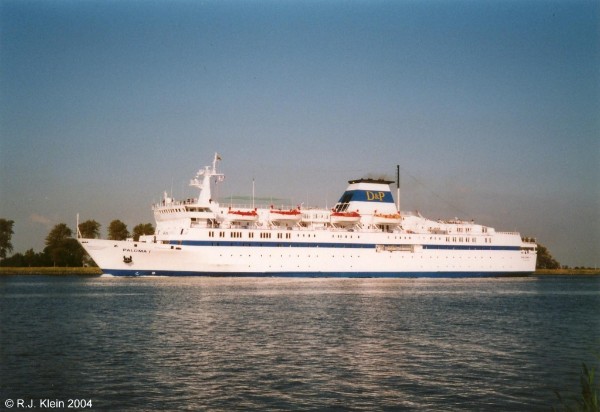Paloma I
In the end of the 1970's the Sovjet-owned state-fleets had a series of seven ships built. They were designed as ferries for services in the Black Sea for Black Sea Shipping Company (BLASCO), in the Far East for the Far Eastern Shipping Company and in the Baltic for Baltic Shipping Company and Estonian Shipping Company. The first ship was launched under the name of Georg Ots in 1979 for the latter company. She was followed by Dmitriy Shostakovich in 1980 for BLASCO, Konstantin Simonov in 1981 for the Baltic Shipping Company, Lev Tolstoy in 1981 for BLASCO, Mikhail Suslov in 1982 and sometime later, Konstantin Chernenko and Mikhail Sholokov in 1986, all for the Far Eastern Shipping Company. The ships were mostly named after writers, singers and musicians who were in favour of the Sovjet leaders and the Communist party.
Dmitriy Shostakovich was launched from the Stocznia Szcsezinska im. A. Warskiego yards at Stettin in Poland in 1980 and measured just under 10.000 tons. Her yardnumber at the wharf had been 492/01. The ship had a lenght of 137,50 meters, she was 21 meters wide and had a draft of 5,80 meters. She was delivered as a cruiseship for 376 passengers and 170 crewmembers. Normally, her cruises took her to the Black Sea and the eastern Mediterranean, sometimes sailing into the western markets for the earnings of valuable cash. This was common practice for Sovjet companies during those years, although the cold war and the iron curtain across Europe mostly kept both worlds wide apart. Later in het carreer, the ship started to be employed in the German market, sailing into the Baltic.

Paloma I is seen sailing the Northsea Canal at the 1st of september 2004, when the former Dmitriy Shostakovich was sailing for Di Maio & Partners.
In 1986, the ship recieved a make-over in Landskrona, Sweden, where she was modernized slightly. This was mainly done because she was more-over meant for the German market, like many ships that were owned by the Sovjet state fleets. Because in Germany several modern ships were added to the fleets of German companies, like the 1980's built Astor sisters (the 1980 one and the 1986 one), she had to be more competible.
In 1991, the Sovjet Union collapsed and the ships of Black Sea Shipping Company were brought over under the flag of Ukraine. Her homeport Odessa stayed the same. In the same year she again had a rebuilding, this time at the Lloyds Werft at Bremerhaven. In this rebuilding, she recieved larger cabins to again meet up more with her more modern counterparts and because of this, her passengercapacity was decreased to 350.
The Black Sea Shipping Company faced hard financial times now the company was no longer state-owned and it seemed that it was very hard to compete with the western lines in the German market. In the year 2000, her owners became Basplan from Odessa, a company set up by BLASCO. In the same year, she was sold to Macro Line of Kingstown, being brought under the vlag of the British Virgin Islands. For them, she lost her former Sovjet name also and was renamed Paloma. Under her new name, she started cruises for the German companies Columbus Leisure Line and Neckermann Seereisen from april onwards, untill august when she was chartered to Hansa Touristik. In this year, her tonnage measurement also increased to 15.586 and her passenger capacity was this time increased to 466, when 58 new cabins were built into her hull. This was done on her former cardeck, that she inherited being designed as a ferry. One year later, during 2001, the ship was sold to Di Maio & Partners, recieving her new hull and funnelcolours as pictured above and renamed slightly to Paloma I. She kept sailing under charter to Hansa Touristik untill march 2007, when the ship was sold Everist Capital Holdings for use as a casinoship in Asia under the name of Royale Star. Management of the ship is now in the hands of V-ships from Monaco, the former owners of Sitmar Cruises. At the 20th of february 2013, the ship was officially starting her services after a ceremony in the port of Rajin, China.

